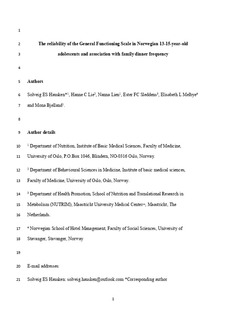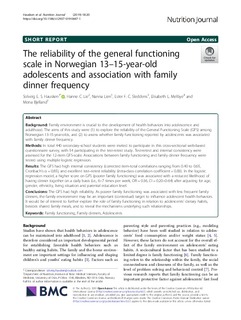| dc.contributor.author | Lie, Hanne Cathrine | |
| dc.contributor.author | Lien, Nanna | |
| dc.contributor.author | Sleddens, Ester F.C. | |
| dc.contributor.author | Melbye, Elisabeth Lind | |
| dc.contributor.author | Bjelland, Mona | |
| dc.date.accessioned | 2020-02-03T10:05:04Z | |
| dc.date.available | 2020-02-03T10:05:04Z | |
| dc.date.created | 2019-04-10T11:11:53Z | |
| dc.date.issued | 2019-03 | |
| dc.identifier.citation | Hausken, S.E.S., Lie, H.C., Lien, N. et al. (2019) The reliability of the general functioning scale in Norwegian 13–15-year-old adolescents and association with family dinner frequency. Nutrition Journal, 18:20, pp. 1-5. | nb_NO |
| dc.identifier.issn | 1475-2891 | |
| dc.identifier.uri | http://hdl.handle.net/11250/2639219 | |
| dc.description.abstract | Background
Family environment is crucial to the development of health behaviors into adolescence and adulthood. The aims of this study were (1) to explore the reliability of the General Functioning Scale (GFS) among Norwegian 13-15-year-olds, and (2) to assess whether family functioning reported by adolescents was associated with family dinner frequency.
Methods
In total 440 secondary-school students were invited to participate in this cross-sectional web-based questionnaire survey, with 54 participating in the test-retest study. Test-retest and internal consistency were assessed for the 12-item GFS-scale. Associations between family functioning and family dinner frequency were tested using multiple logistic regression.
Results
The GFS had high internal consistency (corrected item-total correlations ranging from 0.40 to 0.65, Cronbach’s α = 0.85), and excellent test–retest reliability (intra-class correlation coefficient = 0.83). In the logistic regression model, a higher score on GFS (poorer family functioning) was associated with a reduced likelihood of having dinner together on a daily basis (i.e., 6–7 times per week, OR = 0.36, CI = 0.20–0-64) after adjusting for age, gender, ethnicity, living situation and parental education level.
Conclusions
The GFS had high reliability. As poorer family functioning was associated with less frequent family dinners, the family environment may be an important (contextual) target to influence adolescent health behaviors. It would be of interest to further explore the role of family functioning in relation to adolescents’ dietary habits, besides shared family meals, and to reveal the mechanisms underlying such relationships. | nb_NO |
| dc.language.iso | eng | nb_NO |
| dc.publisher | BioMed Central | nb_NO |
| dc.relation.uri | https://nutritionj.biomedcentral.com/articles/10.1186/s12937-019-0447-1 | |
| dc.rights | Navngivelse 4.0 Internasjonal | * |
| dc.rights.uri | http://creativecommons.org/licenses/by/4.0/deed.no | * |
| dc.subject | ernæring | nb_NO |
| dc.subject | famileforhold | nb_NO |
| dc.title | The reliability of the general functioning scale in Norwegian 13–15-year-old adolescents and association with family dinner frequency | nb_NO |
| dc.type | Journal article | nb_NO |
| dc.type | Peer reviewed | nb_NO |
| dc.description.version | publishedVersion | nb_NO |
| dc.rights.holder | © The Author(s). 2019 | nb_NO |
| dc.subject.nsi | VDP::Medical disciplines: 700::Health sciences: 800::Nutrition: 811 | nb_NO |
| dc.source.pagenumber | 1-5 | nb_NO |
| dc.source.volume | 18:20 | nb_NO |
| dc.source.journal | Nutrition Journal | nb_NO |
| dc.identifier.doi | 10.1186/s12937-019-0447-1 | |
| dc.identifier.cristin | 1691345 | |
| cristin.unitcode | 217,7,6,0 | |
| cristin.unitname | Norsk hotellhøgskole | |
| cristin.ispublished | true | |
| cristin.fulltext | postprint | |
| cristin.qualitycode | 1 | |


